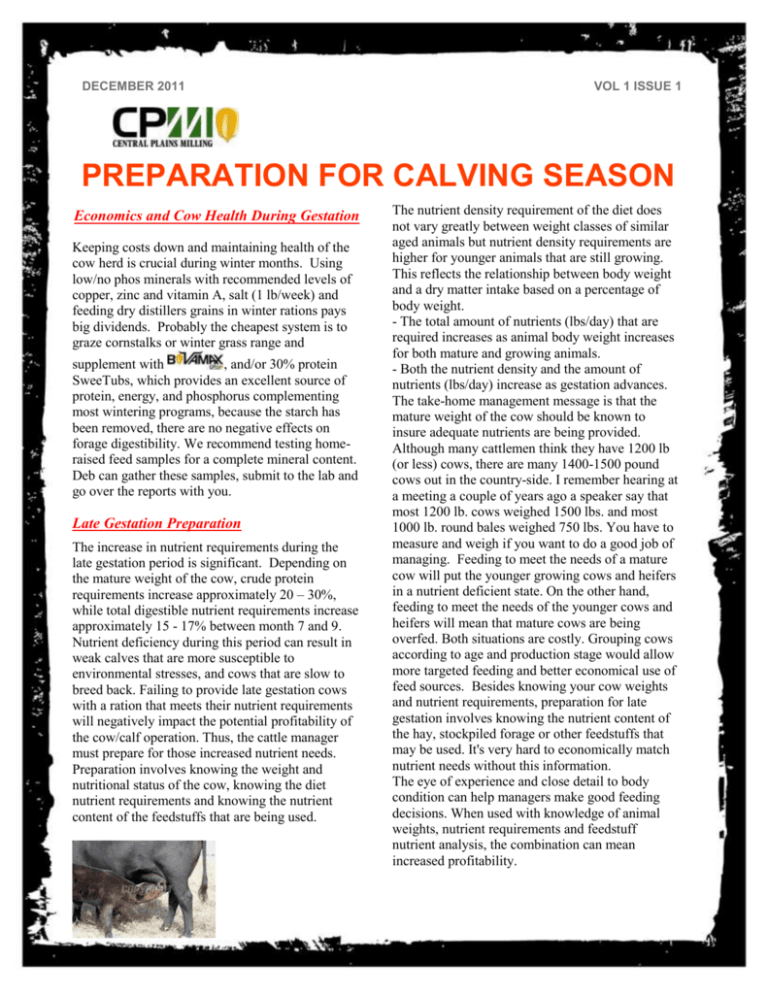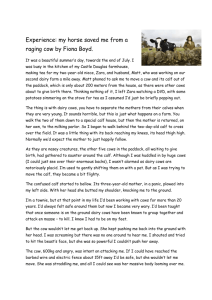preparation for calving season
advertisement

DECEMBER 2011 VOL 1 ISSUE 1 PREPARATION FOR CALVING SEASON Economics and Cow Health During Gestation Keeping costs down and maintaining health of the cow herd is crucial during winter months. Using low/no phos minerals with recommended levels of copper, zinc and vitamin A, salt (1 lb/week) and feeding dry distillers grains in winter rations pays big dividends. Probably the cheapest system is to graze cornstalks or winter grass range and supplement with , and/or 30% protein SweeTubs, which provides an excellent source of protein, energy, and phosphorus complementing most wintering programs, because the starch has been removed, there are no negative effects on forage digestibility. We recommend testing homeraised feed samples for a complete mineral content. Deb can gather these samples, submit to the lab and go over the reports with you. Late Gestation Preparation The increase in nutrient requirements during the late gestation period is significant. Depending on the mature weight of the cow, crude protein requirements increase approximately 20 – 30%, while total digestible nutrient requirements increase approximately 15 - 17% between month 7 and 9. Nutrient deficiency during this period can result in weak calves that are more susceptible to environmental stresses, and cows that are slow to breed back. Failing to provide late gestation cows with a ration that meets their nutrient requirements will negatively impact the potential profitability of the cow/calf operation. Thus, the cattle manager must prepare for those increased nutrient needs. Preparation involves knowing the weight and nutritional status of the cow, knowing the diet nutrient requirements and knowing the nutrient content of the feedstuffs that are being used. The nutrient density requirement of the diet does not vary greatly between weight classes of similar aged animals but nutrient density requirements are higher for younger animals that are still growing. This reflects the relationship between body weight and a dry matter intake based on a percentage of body weight. - The total amount of nutrients (lbs/day) that are required increases as animal body weight increases for both mature and growing animals. - Both the nutrient density and the amount of nutrients (lbs/day) increase as gestation advances. The take-home management message is that the mature weight of the cow should be known to insure adequate nutrients are being provided. Although many cattlemen think they have 1200 lb (or less) cows, there are many 1400-1500 pound cows out in the country-side. I remember hearing at a meeting a couple of years ago a speaker say that most 1200 lb. cows weighed 1500 lbs. and most 1000 lb. round bales weighed 750 lbs. You have to measure and weigh if you want to do a good job of managing. Feeding to meet the needs of a mature cow will put the younger growing cows and heifers in a nutrient deficient state. On the other hand, feeding to meet the needs of the younger cows and heifers will mean that mature cows are being overfed. Both situations are costly. Grouping cows according to age and production stage would allow more targeted feeding and better economical use of feed sources. Besides knowing your cow weights and nutrient requirements, preparation for late gestation involves knowing the nutrient content of the hay, stockpiled forage or other feedstuffs that may be used. It's very hard to economically match nutrient needs without this information. The eye of experience and close detail to body condition can help managers make good feeding decisions. When used with knowledge of animal weights, nutrient requirements and feedstuff nutrient analysis, the combination can mean increased profitability. Control scours with quality nutrition By Deb LaLonde, Central Plains Milling On average, calf scours account for 36 percent of all death losses between birth and 30 days of age. The economic loss for the producer can be anywhere from $50 per calf born to $200 per scouring calf. These losses include the cost of dead calves, stunted calves, labor and medication. As cold winter temperatures set in, these costs and working to prevent calf scours are at the top of every cattle producer’s mind. Scours can be caused by viruses, bacteria and parasites. Disease conditions are created when these agents damage the villi that line the intestinal tract. This damage prevents normal absorption of fluids and nutrients. Weather is one the biggest outside influencers to newborn calves, along with difficult births, poor sanitation, and the reduced health status of the mother. When these conditions are present and the calf’s resistance to disease is lowered, the induction and overload of e-coli and salmonella are more likely to cause lowered production, possibly death. Before calving season gets under way, producers should consider these management tips to prevent scours: Assist with calving Keep a clean area just for calving Practice good sanitation Make sure calves get plenty of colostrum and that they get it quickly within four hours after birth, if possible Move healthy pairs to clean, open pastures Keep cows healthy and nutritionally sound Even before calving, producers should be considering the nutritional program they are implementing with the mother. The last four to five weeks before birth, everything the mother cow has is going into developing a healthy calf and quality colostrum. We need to feed the mother cow properly so she can produce a healthy calf and have good quality colostrum with high levels of antibody titers. A good sound feeding program should be high in protein, vitamins and quality trace minerals with an organic selenium source such as Sel-Plex® from Alltech to boost the immune system for both the cow and calf. This can be given in either a free choice mineral or tub. I also recommend having a program that is inclusive of Bio-Mos® from Alltech. Derived from a select strain of yeast, Bio-Mos supports the gut health and integrity of the calf. By maintaining gut health and stability, we can reduce scouring issues, the producer’s time and labor, cost of medication and loss of gains and death, which increases the bottom line for that producer. As I head into my sixth cow/calf season in Nebraska, I have heard about one success after another across the state of reduced scouring issues, improved overall health status of both cow and calf, less death loss, healthier, heavier calves going to market, improved breed back and increased profitability. I have had producers come to me over and over again or stand up in meetings and say "I will NOT calve without Bio-Mos in my program. That is how much it has improved my overall herd health." Calving Season is fast approaching and we have set the dates for our cow/calf meetings: January 12, 2012 – Howells Community Center, Howells, NE., 12:00 noon. January 13, 2012 – Big Fella’s, Linwood, NE., 12:00 noon January 16, 2012 - Welch’s Pizzeria, Pender, NE., 12:00 noon Another Service From CPM Introducing BEEF TRACKS: • A computer program to track, evaluate and record the performance of a pen of cattle. • Provides a complete record keeping system for the feedlot without additional work. • It uses data collected at the arrival and sale of the cattle along with data collected during feed out. As simple as texting, calling or emailing four points of information on a daily or weekly basis • The type of cattle, environmental factors, feed profile and feed consumed generate performance information. • The consultant’s report can be used to make management decisions on the pen of cattle being fed. • This information is used to evaluate the performance of the pen of cattle, determine when cattle are finished, and compile the close out information when the cattle are sold. • This information can also be used to make decisions on future pens of cattle. Beef producers of the future will have a team that works with them – Cattle Buyer, Veterinarian, Nutritionist, Nutrition Supplier, Cattle Harvester, Banker, and Accountant. None being more important than the other, the team will work with the feedlot owner towards one critical and common goal: IMPROVE PERFORMANCE = INCREASED PROFIT





